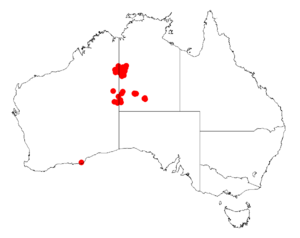Small-leaved flying-saucer bush facts for kids
Quick facts for kids Small-leaved flying-saucer bush |
|
|---|---|
| Scientific classification | |
| Genus: |
Acacia
|
| Species: |
minutifolia
|
 |
|
| Occurrence data from AVH | |
Acacia minutifolia, often called the small-leaved flying-saucer bush, is a unique shrub. It belongs to the Acacia family, which has many different kinds of plants. This special acacia is found only in the dry, hot parts of northwestern Australia. It's called "small-leaved" because its leaves are tiny, and "flying-saucer bush" because of its interesting, flat-topped shape!
Contents
About the Small-Leaved Flying-Saucer Bush
What Does It Look Like?
This shrub usually grows to be about 0.4 to 1 meter (1.3 to 3.3 feet) tall. It spreads out low to the ground, forming a shape like a dome or a flat-topped table. Its bark is mostly smooth, but as the plant gets older, it might develop small cracks. The bark is usually a light grey-brown color.
The branches of the Acacia minutifolia are a bit scaly and can be yellow to red-brown near their tips. Like most Acacia plants, it doesn't have regular leaves. Instead, it has something called phyllodes. These are like flattened leaf stems that do the job of leaves.
The phyllodes of this plant are thick and feel a bit like leather. They grow in small groups of three or four. Each one is tiny, only about 1.2 to 3.2 millimeters long and 0.5 to 1.1 millimeters wide. They have a curved, oblong shape.
When Does It Bloom?
The small-leaved flying-saucer bush usually blooms between April and May, but sometimes as late as August. When it flowers, it produces round flower-heads that are about 5 to 9 millimeters across. These flowers are typically yellow or a pale yellow color.
How Was It Named?
The first official description of Acacia minutifolia was made in 1874. A botanist named Ferdinand von Mueller wrote about it in his work called Fragmenta Phytographiae Australiae.
Later, in 2003, another botanist named Leslie Pedley reclassified it. He moved it to a different group called Racosperma minutifolium. However, in 2006, it was moved back to the Acacia group, where it remains today.
Where Does It Grow?
This special acacia plant is found in several parts of Australia. You can find it in the Northern Territory and in different regions of Western Australia. These areas include the northeastern Goldfields-Esperance, the eastern Pilbara, and the southeastern Kimberley regions.
It likes to grow in rocky soils. In the Northern Territory, it's often found in western areas like the Great Sandy Desert, MacDonnell Ranges, Tanami Desert, and Central Ranges. It prefers gravelly or rocky areas, especially those with acidic rocks. Sometimes, it can also be found on stony rises or even on sandy plains.

